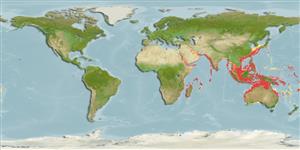Common names from other countries
Issue
Species spelling Eschmeyer, pers. comm.
Environment: milieu / climate zone / depth range / distribution range
ນິເວດວິທະຍາ
ສັດທະເລ ກ່ຽວກັນຫີນ; ລະດັບຄວາມເລິກ 7 - 200 m (Ref. 11298). Tropical
Indo-Pacific: East Africa, throughout the Indian Ocean to the Indo-Australian Archipelago and New Caledonia, north to southern Japan.
ຂະໜາດ / ນ້ຳໜັກ / Age
Maturity: Lm ? range ? - ? cm
Max length : 15.0 cm TL ຕົວຜູ້/ບໍ່ມີເພດ; (Ref. 11298); common length : 10.0 cm TL ຕົວຜູ້/ບໍ່ມີເພດ; (Ref. 3322)
ຄີຫຼັງຂອງປາ (ຄີອ່ອນ) (ທັງໝົດ) : 81 - 87; ຄີກົ້ນຂອງປາ: 61 - 65; ສັດທີ່ມີກະດູກສັນຫຼັງ: 24. This species is distinguished by the following characters: body deeply ovoid; caudal fin with a pair of black blotches, arranged between the third and fourth fin rays from upper- and lowermost rays in the fin; the ocular-side pectoral fin is not elongate, and no sexual differences in its length; gill rakers are very short, not serrate (Ref. 126076).
Description. D 81-87; A 61-65; pectoral-fin rays on ocular-side 10-12, blind-side 8-10; caudal-fin rays 3 + 11 + 3; pelvic-fin rays on ocular-side 6, blind-side 6; lateral line scales 40-45; gill rakers 0 + 5-7; vertebrae 10 + 14 (Ref. 126076).
Found on sandy and muddy areas of the continental shelf. Feeds on crustaceans, polychaetes, and other benthic animals (Ref. 9824). Marketed fresh and sometimes dried (Ref. 9824).
Life cycle and mating behavior
Maturities | ການສືບພັນ | Spawnings | Egg(s) | Fecundities | ຕົວອ່ອນ
Amaoka, K., E. Mihara and J. Rivaton, 1993. Pisces, Pleuronectiformes: Flatfishes from the waters around New Caledonia. - A revision of the genus Engyprosopon. p. 377-426. In A. Crosnier (ed.) Résultats des Campagnes MUSORSTOM, Volume 22. Mém. Mus. natn. Hist. nat. (158):377-426. (Ref. 9558)
IUCN Red List Status (Ref. 130435)
CITES (Ref. 128078)
Not Evaluated
Threat to humans
Harmless
Human uses
Can't connect to MySQL database (fbapp). Errorcode: Too many connections
